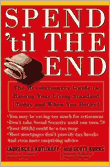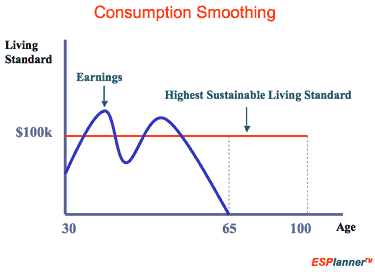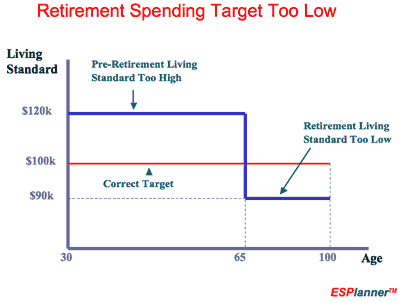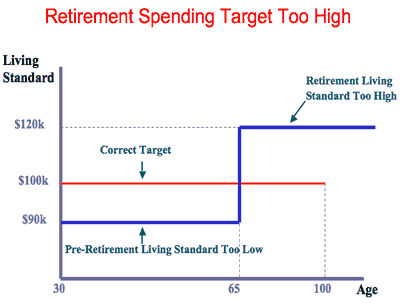 I just finished reading the book Spend ‘Til the End: The Revolutionary Guide to Raising Your Living Standard–Today and When You Retire by Burns and Kotlikoff. One of the main themes of the book is consumption smoothing, which is an economic theory where the primary goal of financial planning is to avoid abrupt changes in one’s standard of living.
I just finished reading the book Spend ‘Til the End: The Revolutionary Guide to Raising Your Living Standard–Today and When You Retire by Burns and Kotlikoff. One of the main themes of the book is consumption smoothing, which is an economic theory where the primary goal of financial planning is to avoid abrupt changes in one’s standard of living.
This can actually be a very controversial goal, because it may ask you to borrow money or even stop saving at times, in order to maintain a constant standard of living. Here is an illustration of this idea taken from the website for ESPlanner, which is a financial planning software package made by Kotlikoff.

Note that consumption smoothing can be very different from what other traditional methods propose. For example, one traditional goal is to replace 75-100% of your current income in retirement. Another generic rule of thumb (which they call “rules of dumb”) might be to simply save 10-15% of your annual income. The authors argue that these one-size-fits-all approaches can greatly overestimate or underestimate the amount of saving one’s family needs to do, leading to the dreaded “standard of living disruption”:


As far as they are concerned, both scenarios are equally bad. Undersavers might die broke. Oversavers are misers and compared to the mentally insane.
Replacement Rates Are Stupid, But Is Smoothing Better?
Now, I would agree that those 5-minute retirement calculators like Fidelity’s MyPlan Calculator or T. Rowe Price’s Retirement Income Calculator can be really off.
For example, Fidelity’s calculator assumes I will need 85% of my pre-retirement income in retirement. But what if my kids are grown up and we’ve already paid for college tuition? What if our house is paid off? What if it isn’t? All these things change what income we need. Look at us – I’ve already calculated that our total non-housing expenses are around $30,000 year – this is less than 15% of our current combined income. An 85% replacement rate would inflate our nest egg target by millions of dollars!!
So yes, inflexible replacement rates are stupid, but I don’t know if consumption smoothing is that much better. I would use ESPlanner, but it costs $200. It is plugged so much in the book that I feel like book buyers should have gotten a free 30-day trial at least to play with it. But I’m betting that even with the smoothing approach, the software will simply say something like “you can maintain a maximum spending standard of $80,000 every year.” Still much more than I need to spend to be content.
I would rather have each household try to estimate their own spending needs from the ground up, and not just spend what some software program tells you to spend. What makes you happy? What are your priorities? What is enough? Then, find a way to create that income.
Predicting The Future
Here’s the problem with all these future calculators. Any time you extrapolate 30 years into the future, any slight change in inputs can throw things way off. Let’s say you think your investments will average 8% returns annually. What happens if it’s only 6%? You estimate inflation at 3%. What if it’s 4%? What if you are 60% stocks/40% bonds, nearing retirement, and your stocks drop 40% in less than a year (*ahem*)? Finally – what about jobs? People switch jobs, careers, geographic locations. Income isn’t so predictable either.
With all this uncertainty, having a calculator tell me I can spend $68,644.55 this year and every year after that just doesn’t seem right.
I don’t know about you, but I see running out of money as a lot worse than ending up with too much. Accordingly, I simply view retirement (financial independence, whatever) as a goal to be reached as soon as possible, while still enjoying life along the way.
Positive Consumption Slope?
Just a thought, but I don’t know if I would want a constant standard of living anyway. I would rather having a slowly improving standard of living, so that life is (supposedly) getting a little better as I go.
Still, consumption smoothing is an neat concept, and the book goes on to extend it into a number of other interesting examples. More to come…
 The Best Credit Card Bonus Offers – March 2024
The Best Credit Card Bonus Offers – March 2024 Big List of Free Stocks from Brokerage Apps
Big List of Free Stocks from Brokerage Apps Best Interest Rates on Cash - March 2024
Best Interest Rates on Cash - March 2024 Free Credit Scores x 3 + Free Credit Monitoring
Free Credit Scores x 3 + Free Credit Monitoring Best No Fee 0% APR Balance Transfer Offers
Best No Fee 0% APR Balance Transfer Offers Little-Known Cellular Data Plans That Can Save Big Money
Little-Known Cellular Data Plans That Can Save Big Money How To Haggle Your Cable or Direct TV Bill
How To Haggle Your Cable or Direct TV Bill Big List of Free Consumer Data Reports (Credit, Rent, Work)
Big List of Free Consumer Data Reports (Credit, Rent, Work)
I read this book over the summer. It is the first book on retirement planning that applies refreshingly unique logic and economic science to the subject. Most other books and pundits merely re-hash ingrained rules of thumb (rules of “dumb” as Burns calls them.) In my opinion, this book is a must read for every financial planner and long term investor.
Of course Fido and some others would inflate your required nest egg. More money under management for them.
That’s just about the reaction that I had.
The idea that you can look ahead for 30 years or more and see the shape of your career well enough to produce a useful estimate of your lifetime earnings is just silly. And yet, their whole scheme is predicated on being able to do just that.
Having said that, though, I think it’s still a useful theoretical framework for making financial decisions. When applying it in the real world you’ll have to adjust things to take into account the unknowns, but it’s still a useful structure for doing the analysis.
I guess I side more with Jonathan on this — for me, financial independence is something to be attained as quickly as possible, so that there are more options later on. Having flexibility with my job, location, and standard of living are far more satisfying for me than overspending now, only to find out I may have overshot if any input changes. More options = more freedom = more happiness, in my book 🙂
While the media seems to be pounding on the fact that this book mentions that you may be “saving too much” for retirement, I don’t think that is the important take away.
My take away from the book is not that you can save less and still meet your retirement needs … it is that you can TAKE LESS RISK with your retirement savings investments and still meet your retirement needs.
When people see that “you need 85% of your pre-retirement income”, the typical reaction isn’t to scrimp and save more. The most likely reaction is to pile all their money into the stock market to get maximum growth so as to meet that goal.
Realizing that you don’t need as much retirement savings to retire comfortably should allow you to dial down the risk in your retirement investments – something a lot of people probably wish they had done right about now.
Quoted for Truth: Here’s the problem with all these future calculators. Any time you extrapolate 30 years into the future, any slight change in inputs can throw things way off.
Here’s how I explain it to people.
If you save 10% of your income for 40 years, you have effectively saved 4 years worth of income (no interest, no inflation, simple numbers). Or to be more precise, 4 years of your average working income across that whole period.
Now, if you add interest / capital gains, but subtract inflation, you typically end up with some small one digit percentage of average growth across the period. It’s then easy to calculate the value of that 1 or 2% difference over the work life.
It also lets you estimate in terms of “how you’re living now” or the “average of your lifestyle from 22 to 65”. This is much cleaner than trying to calculate numbers and manage inflation over time.
To me the big key is that you calculate for retirement in “years of average income”. This measurement cancels out much of the inflation problem and actually provides people with a reasonable gauge.
ToughMoneyLove – I agree. I’m still working on the overall review, but I do agree that this book is both fresh and useful.
Philip – Agreed, the worked-out examples in the book are reason enough to read the book.
J – I am definitely coming around to agreeing with you as well. Risk is risk, there is no need for everyone to be taking the same amount.
Gates VP – Especially if one is going for early retirement, you are right, there is limited time to grow. Instead of income, I’d measure it in terms of % of current spending. Like “I saved 2 years of future spending” instead of “10% of today’s income”.
Good point that spending patterns could be drastically different once you retire. Almost everyone will switch to a different health care plan during retirement years, and no one can estimate what medical reimbursement will look like in 20-30 years. If we continue at the current pace, the cost of health care will trump any worries over a 4% vs. 8% return.
Hey Vern: If we continue at the current pace, the cost of health care will trump any worries over a 4% vs. 8% return.
If it’s any consolation, as a Canadian living in the US, I can already tell you that you’ll be looking at some form of two-tiered public medicine in 20-30 years.
Less and less people are getting adequate medical coverage and despite medical advances, the quality of certain basic services (like child-birth procedures) have decreased. You guys actually had to write a law requiring that women are provided with a minimal hospital stay after birth. Doesn’t that sound a like band-aid to a larger underlying problem?
The medical situation in the US in pretty much untenable b/c the overhead is so ridiculously high. I would definitely not want to try to plan for medical expenses in 30 years.
Here’s another take on consumption smoothing vs the traditional income replacement advice:
http://www.esplanner.com/case-smoothing-consumption-vs-online-calculators
You are missing the bigger point here I think. Nothing about consumption smoothing disallows you to tell the software that you want to end life with x dollars in the bank, or an estate to one’s heirs, or for that matter, that you want your living standard to rise by 2% per year until you are 80 and then decline by 3% per year. That’s easy and this option is programmed into ESPlanner. As this case study, linked above, points out, it’s an approach or methodology. How you use the tool and make it work for your own preferences is entirely up to you.